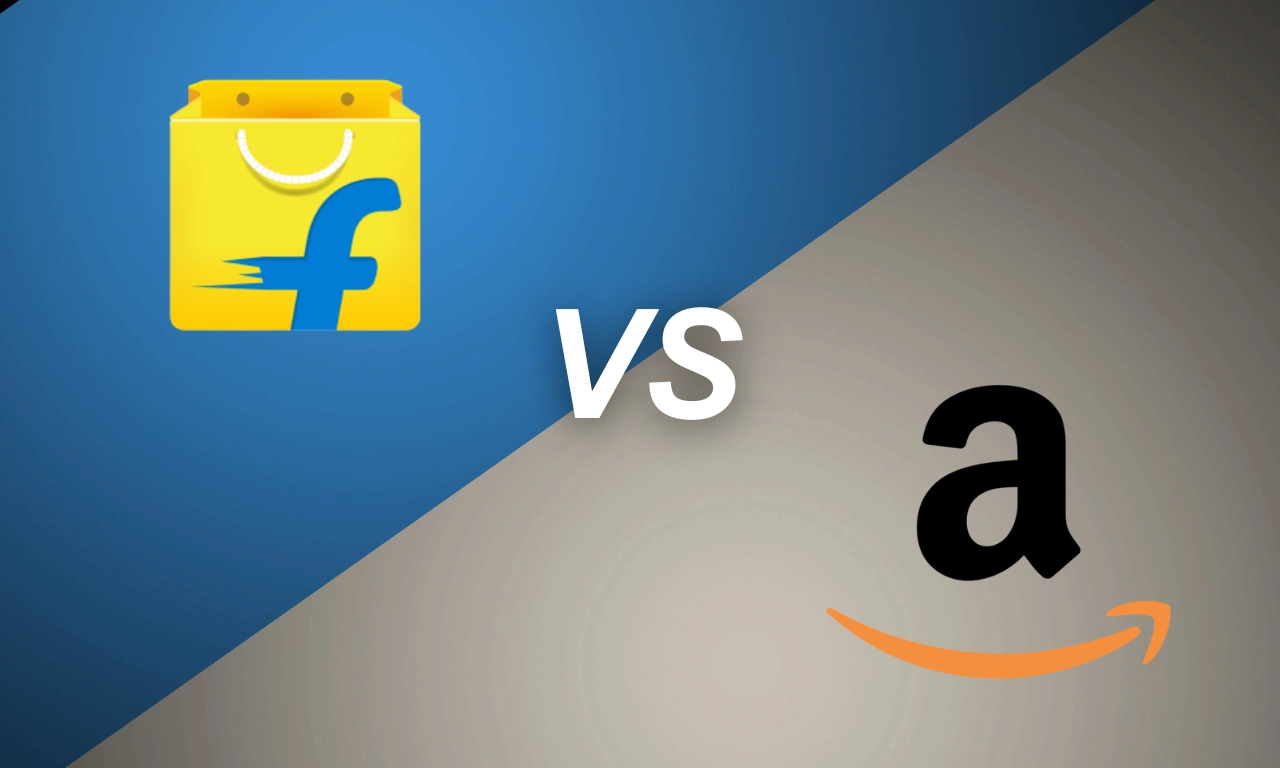Amazon vs Flipkart Which is Better In India for Sellers 2025 Guide

Your next platform decision could cost or save you lakhs. Amazon just eliminated fees for products under ₹300. Flipkart launched credit-based advertising. Both platforms rewrote their logistics playbooks.
The Amazon vs Flipkart choice now swings seller margins by 8-15% or more. That's the difference between profitable growth and barely breaking even. With India's e-commerce hitting ₹10.82 lakh crore in 2024, picking the right platform (or using both strategically) determines who thrives and who struggles.
This guide cuts through the marketing noise with actual fee calculations, payment timelines, and platform-specific strategies that work.
Why compare Amazon and Flipkart and the comparison factors
Platform fees and logistics choices swing contribution margins by 8-15% or more. Cash-flow timing can make or break replenishment cycles. We're comparing five critical factors that directly impact your bottom line:
- Fees: Commission rates, closing fees, shipping charges, storage costs, and return handling fees. The complete cost structure that determines your unit economics.
- Ads and promos: CPC vs credit-based models, ad formats, Brand Registry requirements, and actual ROAS data from campaigns.
- Logistics and fulfilment: FBA vs FBF costs, Prime vs F-Assured badges, speed-to-customer metrics, and control over the delivery experience.
- Payments and taxes: Settlement cycles (7 vs 14 days), TCS deductions at 0.5%, GST at 18% on fees, and working capital implications.
- Business model fit: Which platform suits your ticket size, category, inventory turnover, and capital constraints.
How much does Amazon really charge sellers?
Amazon's fee structure underwent its biggest transformation in April 2025. Here’s the complete fee structure to find out flipkart or amazon which is better.
The zero-fee revolution on Amazon
For products priced below ₹300, Amazon eliminated referral fees across 135+ categories including apparel, home, beauty, and grocery.
A seller listing a ₹299 t-shirt saves ₹34 per unit compared to the previous 13.5% referral fee.
But sellers still pay:
- Closing fees: ₹21-51 depending on the product
- Weight handling: ₹17 for items under 1kg
- GST: 18% on all fees
Premium product fees remain substantial
Products above ₹300 follow a different fee structure:
| Price range | Referral fee | Closing fee | Typical total |
|---|---|---|---|
| ₹300-500 | 2-10% | ₹21 | 7-10% |
| ₹500-1000 | 8-15% | ₹26 | 12-17% |
| ₹1000+ | 10-20% | ₹51+ | 15-25% |
Electronics and appliances sit at the higher end (10-25%), while books and groceries enjoy lower rates (2-10%).
Total referral fees = Price of each item x Referral fee percentage
The April 2025 update created a clear strategy: push volume on low-value items, maintain margins on premium products.
FBA adds convenience at a cost
Fulfilment by Amazon remains popular despite the fees:
- Storage: ₹45 per cubic foot monthly
- Pick and pack: ₹17 (standard), ₹26 (oversized)
- Peak season surcharge: 2x rates during October-December
But there’s a big upside to it. Automatic Prime eligibility, which increases conversion rates by 30-40%. For products with decent margins, FBA often pays for itself through higher sales velocity.
Note: All the Amazon fees and pricing structure[1] are as of September 2025. Make sure you check the pricing for your category, product, and weight.
Flipkart's consistent commission structure
If you’re trying to figure out: Flipkart or Amazon which is better, pricing is crucial.
Well, Flipkart maintains a more predictable fee model. Unlike Amazon's price-based tiers, Flipkart charges consistent commission rates by category, whether you use their fulfilment service or ship independently.
Commission rates that don't surprise
Flipkart's commission structure stays steady:
- Electronics: 5-8%
- Fashion & Lifestyle: 8-15%
- Home & Kitchen: 9-11%
- Beauty & Personal Care: 10-15%
- Books & General: 7-12%
Note: The commission fee changes as per the category.
No zero-fee tiers exist, but rates don't jump dramatically at price thresholds either. This predictability helps sellers maintain consistent margins across their catalog.
Additional fees add up
Beyond commission, sellers pay:
Fixed fees by price: ₹14 – ₹50 on a per order basis (as per product price slabs)
Shipping charges vary by distance and weight:
- Local (same city): ₹5
- Zonal (same state): ₹20
- National: ₹25
*The pricing stated above is as per an order of 1kg.
Collection fees for payment processing:
- Prepaid orders: 2%
- Cash on delivery: 3% + ₹20
Note: There are multiple layers to the Flipkart pricing model[2], and it changes based on weight, product type, and your plan. Make sure you check the official structure before deciding.
Real cost comparison: Amazon vs Flipkart which is best?
Let's calculate fees for a ₹599 bluetooth speaker (400g):
Amazon:
- Referral: ₹53.91 (9% electronics)
- Closing: ₹26
- Shipping: ₹17
- Total: ₹96.91 (16.2%)
Flipkart:
- Commission: ₹41.93 (7% electronics)
- Fixed: ₹30
- Shipping: ₹25
- Collection: ₹11.98
- Total: ₹108.91 (18.2%)
Bottomline: In this comparison of Amazon or Flipkart which is best, Amazon wins on fees, but Flipkart's faster payment cycle changes the equation for cash-conscious sellers.
The advertising game changer: Amazon vs Flipkart
Advertising drives massive sales on both platforms. But how you pay for those ads makes all the difference to your cash flow.
Amazon's pay-first model
Amazon Ads operates like Google - you fund your account, run campaigns, and hope for returns.
Amazon Ads supports multiple billing methods:
- Ads Wallet (advance deposit) — fees deducted from a prepaid balance.
- Seller Balance — fees deducted from your seller account funds.
- Cards/other methods depending on account type.
The system offers different targeting with Sponsored Products, Sponsored Brands (requires Brand Registry), and Sponsored Display ads.
During peak seasons, that requirement doubles. Many sellers can't afford to lock up this capital while waiting for sales and payments.
Before you switch on ads, tighten your Amazon SEO - titles, bullets, search terms, and images - to lower CPC and lift conversion.
Flipkart's ANPL disruption
Flipkart's Advertise Now, Pay Later (ANPL) changes a lot of things. You get advertising credit based on your selling history, run campaigns immediately, and the amount is deducted from next month’s Flipkart earnings - interest-free.
Flipkart supports Product Listing Ads /Product Contextual Ads and is already used by 24,000+ sellers.
Bottomline: In this comparison of Amazon or Flipkart which is best for ads - there’s no clear winner! You should run Flipkart ads if you are tight on budget and have cash flow issues. But Amazon is better for scale and brand building. Run both if you have the budget.
Logistics showdown: Prime vs F-Assured
Both platforms offer seller-fulfilled and platform-fulfilled options, but their logistics management and execution differ significantly.
Amazon's fulfilment advantage
FBA (Fulfilment by Amazon) provides:
- Automatic Prime badge
- 1-2 day delivery in metros
- Customer service handled by Amazon
- Easy returns processing
Easy Ship offers middle ground, where Amazon handles delivery while you manage inventory. It's cheaper than FBA but doesn't earn Prime badge.
To build trust alongside Prime, learn how to earn the Best Seller badge on Amazon and when it meaningfully boosts CTR.
Flipkart's balanced approach
FBF (Fulfilment by Flipkart) delivers:
- F-Assured badge eligibility
- 2-3 day standard delivery
- Ekart logistics network
- Competitive storage rates
Bottomline on Amazon or Flipkart which is best in logistics: Flipkart charges the same commission for FBF and non-FBF orders, while Amazon's fee structure varies by fulfilment method.
Amazon vs Flipkart payment cycles: The cash flow reality
This is where Amazon or Flipkart which is best becomes a cash flow question.
Amazon's payment schedule:
- First payment: 14 days after first sale
- Reserve period: 7 days rolling
- Net effect: 21-day cash conversion
- Example: If an order is delivered on D+3, funds become available on D+10 (DD+7), then disbursed on your next 7-day settlement date, with bank credit typically 12 days later.
Flipkart's faster cycle:
- Standard: 7 days from dispatch
- Net effect: 7-day cash conversion
- Example: If an order is dispatched on D+2, Flipkart’s claim is payout ~D+9 (7 days from dispatch), subject to adjustments.
Bottomline on Amazon vs Flipkart in payment cycles: Flipkart wins by providing faster settlements, which can lower external working-capital needs.
However, quantify this for your catalogue by comparing (days of sales locked in Amazon’s DD+7 + weekly cycle) vs (Flipkart’s 7-days-from-dispatch), then multiply by your average daily GMV.
Amazon or Flipkart: Which platform fits your business model?
The Amazon vs Flipkart which is best answer depends on your specific situation.
Best for Amazon
- Low-value, high-volume products (under ₹300): Zero referral fees make previously unprofitable items viable. A seller moving 5,000 units monthly saves ₹1.5-2 lakhs in fees.
- Brand-focused businesses: Prime customers have higher lifetime value. If you're building a premium brand, Amazon's customer base justifies higher fees.
- International aspirations: Amazon provides a pathway to global selling that Flipkart doesn't match.
If Amazon is your primary growth lane, use this playbook to increase sales on Amazon.
Best for Flipkart
- Capital-constrained startups: ANPL advertising and 7-day payments dramatically reduce working capital needs. You can scale with 40% less capital than on Amazon.
- Electronics and appliances: Lower commission rates (5-8% vs Amazon's 14-17%) and better EMI integration make Flipkart ideal for high-ticket electronics.
- Regional and ethnic products: Flipkart market penetration in tier 2/3 cities exceeds Amazon's reach - in this case, is Flipkart an Indian company matters for local trust.
If you’re choosing Flipkart, follow the Flipkart seller registration steps to activate your account and logistics pickup quickly.
The dual-platform strategy
Smart sellers leverage both. Here's the optimal split:
- 70% catalog on both platforms: Maximise reach and hedge against platform changes.
- 20% Amazon-exclusive: Prime-optimised bundles and subscribe-and-save products.
- 10% Flipkart-exclusive: EMI-focused electronics and regional specialties.
This approach typically generates more revenue than single-platform strategies.
Is selling on Flipkart profitable in 2025?
Is Flipkart profitable for sellers? The data says yes, with caveats.
Flipkart revenue hit ₹70,844 crore[3] in FY2024. With Flipkart net worth increasing and Walmart's backing, the platform isn't going anywhere.
Categories performing well on Flipkart include fashion (via Myntra integration), mobile phones (exclusive launches), and large appliances (superior EMI options).
The Flipkart e-commerce ecosystem particularly rewards sellers who understand Indian buying patterns - festival shopping, EMI preferences, and cash-on-delivery needs.
Amazon vs Flipkart: The market share battle
Amazon India revenue and Flipkart revenue tell an interesting story. Flipkart maintains 48% market share versus Amazon's 31%, but Amazon is growing faster. Moreover, both platforms face pressure from quick commerce players in groceries and essentials.
As Amazon competitors go, Flipkart remains the strongest challenger in India. The Flipkart business model of deep localisation, vernacular support, and seller-friendly payment terms resonates with Indian merchants and consumers alike.
For a sense of category expansion beyond core retail, see how online automobile shopping in India is accelerating across Amazon and Flipkart.
Amazon or Flipkart: Let your growth partners pick the best platform for your needs
The Flipkart or Amazon which is better debate misses the larger opportunity. In the current e-commerce space, platform arbitrage beats platform loyalty.
Amazon's zero-fee structure for sub-₹300 products creates clear advantages for volume sellers. Flipkart's ANPL and 7-day payments solve working capital challenges that kill many businesses.
The sellers who understand each platform's strengths and exploit them systematically will dominate their space. Start with small tests, scale what works, and stay flexible as platforms evolve.
Ready to optimise your marketplace strategy? GrowthJockey's experience of building 360° marketplace has helped numerous e-commerce brands grow beyond ₹100Cr in a matter of months.
Schedule a consultation to build your dual-platform growth engine.
FAQs on Amazon vs Flipkart which is best
Which platform has lower seller fees in 2025?
Amazon vs Flipkart fees depend on your product price. Amazon offers zero referral fees under ₹300, beating Flipkart's 5-10% commission. Above ₹500, fees become comparable and varies as per the category.
Who pays sellers faster?
Flipkart pays in 7 days from dispatch. Amazon has a 14-day initial hold, then weekly payments. This makes Flipkart's payment cycle 7-14 days faster, significantly improving cash flow.
Does Flipkart have an FBA equivalent?
Yes, Fulfilment by Flipkart (FBF) offers storage, pick-pack, and shipping via Ekart. It provides F-Assured badge eligibility, similar to Prime. FBF costs are generally 10-15% lower than FBA.
What taxes apply to marketplace earnings?
Both platforms deduct 0.5% TCS (0.25% CGST + 0.25% SGST). All marketplace fees attract 18% GST. While GST is claimable as input tax credit, it impacts immediate cash flow.
Which platform suits new sellers better?
Flipkart or Amazon which is better for new sellers depends on capital. Flipkart's ANPL, 7-day payments, and no Brand Registry requirement favour bootstrapped startups. Amazon's zero-fee tier and Prime audience benefit established brands with sub-₹300 products.








